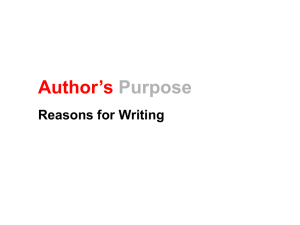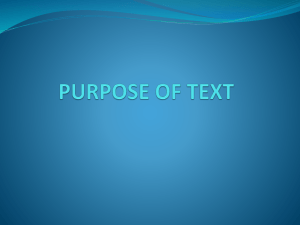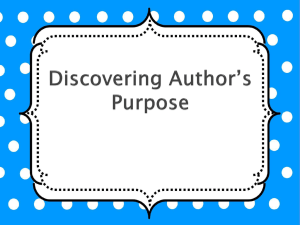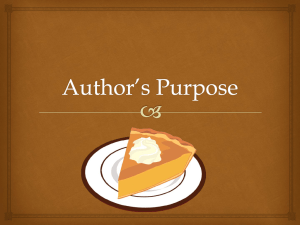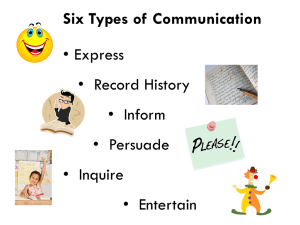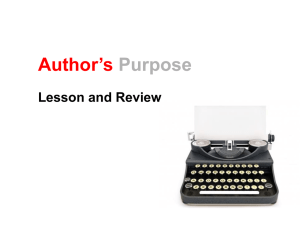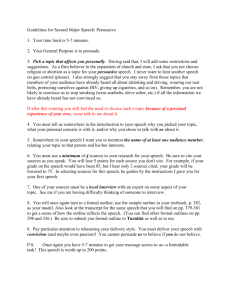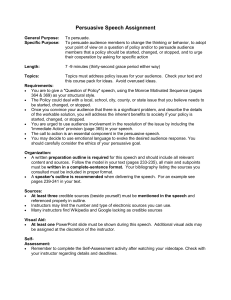What is author's purpose
advertisement
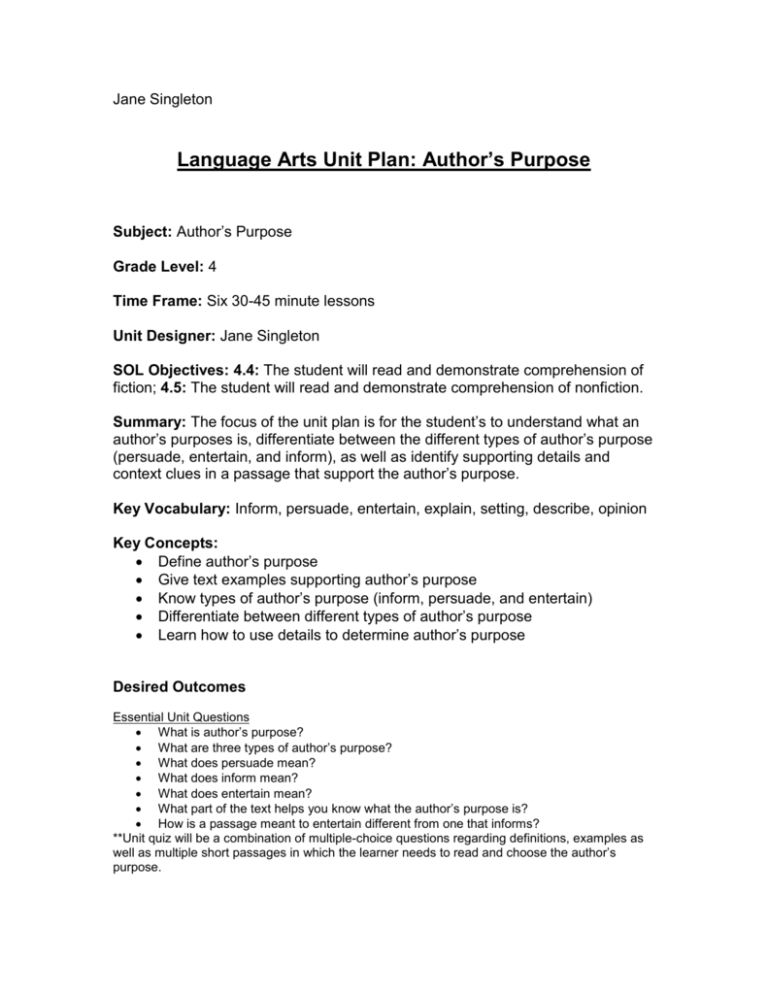
Jane Singleton Language Arts Unit Plan: Author’s Purpose Subject: Author’s Purpose Grade Level: 4 Time Frame: Six 30-45 minute lessons Unit Designer: Jane Singleton SOL Objectives: 4.4: The student will read and demonstrate comprehension of fiction; 4.5: The student will read and demonstrate comprehension of nonfiction. Summary: The focus of the unit plan is for the student’s to understand what an author’s purposes is, differentiate between the different types of author’s purpose (persuade, entertain, and inform), as well as identify supporting details and context clues in a passage that support the author’s purpose. Key Vocabulary: Inform, persuade, entertain, explain, setting, describe, opinion Key Concepts: Define author’s purpose Give text examples supporting author’s purpose Know types of author’s purpose (inform, persuade, and entertain) Differentiate between different types of author’s purpose Learn how to use details to determine author’s purpose Desired Outcomes Essential Unit Questions What is author’s purpose? What are three types of author’s purpose? What does persuade mean? What does inform mean? What does entertain mean? What part of the text helps you know what the author’s purpose is? How is a passage meant to entertain different from one that informs? **Unit quiz will be a combination of multiple-choice questions regarding definitions, examples as well as multiple short passages in which the learner needs to read and choose the author’s purpose. Differentiated Unit Goals All Students will: Define author’s purpose Define persuasion Define to inform Define entertain Identify a detail supporting detail Most Students Will: Compare and contrast passages that are persuasive vs. entertaining Identify persuasive reasoning in a text Infer what the author’s purpose is within a passage Differentiate between persuade, entertain and inform Some students will: Apply persuasive and entertaining details in their writing Evidence of Meeting Unit Outcomes Assessments: PIE homework sheet 1. Student must provide environmental examples of material that is persuasive, informative and entertaining In-class independent work sheets 1. Demonstrate knowledge of using text to find supporting details 2. Appropriately identify author’s purpose in a passage Persuasive list, bubble map, or paragraph: After introducing persuasion as the Author’s purpose and reading “The True story of the three little Pigs” students based on current skill level will use their knowledge of persuasion to list supporting details in a story, create a bubble map or write a letter to the “judge” persuading him that the wolf is not guilty. Author’s purpose quiz 1. Demonstrate knowledge of the 3 types of author’s purpose 2. Infer the author’s purpose through using the text 3. Identify examples of the 3 types of author’s purpose Modifications: Students may have 3 choices instead of four on the multiple choice and lower grade level passages. Writing assignment would be modified with choices listed above. Other evidence: Oral assessments will be given during each lesson byt both calling on individual students and using choral response when appropriate. Outline of Unit Lesson 1: Put students in groups and let them determine why the article they were given was written Introduce concept of author’s purpose (reason for writing) Introduce the mnemonic PIE (Persuade Inform Entertain) Discuss with class examples of each Provide on basket for each type of author’s purpose at from of room and let groups determine and place their article where they think it belongs. Homework: Give PIE sheet to students and tell them to write an example under each. Lesson 2: Reintroduce Persuasion Give examples of why people use persuasion a. To get something (candy, free-time) b. To change people’s opinion (politics, government) c. To get people to take action (i.e. buy, sell) Read the “True Story of the Three Little Pigs” Discuss and brainstorm as a class how the wolf is persuasive Have students make a bubble map with either the wolf is guilty or not guilty and five reasons why. Lesson 3: Reintroduce concept of Inform Give examples of reasons people read things to be informed o To learn how to do something o To make decision (read about the weather to know if you need to bring umbrella) Read a historical article about Jamestown (have copy for the students) Prompt class to discuss what they learned from the article Discuss how it’s different from persuasion. Give students in-class worksheet with 4 different passages and decide which ones are to persuade and which are to inform. Lesson 4: With the help of students make a list on the board of things that are for entertainment (i.e. movies, T.V. shows, stories, games) Explain how an author entertains o Humor o Action o Mystery o Fantasy Read a passage from Diary of a Wimpy Kid Have students orally share what words or sentences they found entertaining. Choice Center activity Lesson 5: Do a review of each of the types of author’s purpose (PIE) Present/discuss skills students can use to help identify the author’s purpose in a passage Introduce and review the concepts within the mnemonic LISA and “choice of Language, specific Information, Setting, and Audience” Give a handout with three PIE passages and as a class highlight the language and specific information that supports the author’s purpose, define the audience and the setting. Let students work independently on a worksheet where they match the short passage to the author’s purpose and highlight “LISA” clues they find. Review the answers in class Lesson 6: Do a quick review of examples of PIE Quiz on Author’s purpose Pre-requisite Skills: Ability to write a complete sentence Understanding the concept of a supporting detail Comprehension skills Vocabulary knowledge to describe author’s purpose Ability to write with details Accommodations: Option to write fewer reasons or sentences in their writing assignments. Provide an electronic spell checker and assistance and option to orally convey ideas instead of writing them. Add visuals to the quiz and let students choose from 3 multiple choices answers instead of four. Give students with learning disabilities lower level passages to read and read all assessments aloud to children. For a student with AD/HD incorporate kinesthetic activities into the unit in order to allow them to use up their extra energy.
